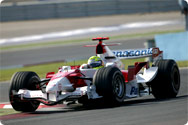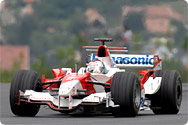Thank you all so much for your continued support. I am Tsutomu Nagashima, Senior Executive Coordinator at TMG in charge of chassis development and design. This week, I will be filing a report for the circuit on behalf of Mr. Arai.
 |
 |
| The newly updated TF106B, featuring a set of new aero parts, was unveiled at the Turkish Grand Prix. The most easily visible difference is the sharp curvature in the section hanging from the center part of the front wing. This was the same shape seen during the North American round, but several detailed changes have been made to the shape. |
|
 |
Seeking a performance jump going into the final stage of the championship
First, let me touch on some changes we made going into the Turkish Grand Prix. One change has been made to the front wing of the TF106B. Although it might not seem much different at first glance, the change has resulted in quite a bit of improvement. We had been making preparations to introduce this change two months ago, but our test results indicated that the changes weren’t quite ready. We reworked the section, and finally introduced the changes here at this race.
With the introduction of the new front wing, I think we are very close to the point where we can say we’re satisfied with the aerodynamics. The drivers, on the other hand, seem to be reluctant to admit that the car is better, no matter how much improvement we make. We have noticed a decrease in complaints about this section or that compared to prior iterations, so we’ll take that as proof that the drivers are noticing the improvements.
| |
 |
 |
This is the chassis used in the prior race at the Hungarian Grand Prix. Compared to the Turkish Grand Prix specification, the curvature of the center of the front wing is gentler, melding into the spherical shape of the left and right wings. |
 |
Besides the front wing, we have made several other aerodynamic improvements, even though they might not be obvious. Our brake duct setup projects only a medium load on the brakes, but we have made some small changes in shape. Considering all of the changes to various sections of the car, I think we have achieved quite a volume of improvements. It feels like we have finally completed the homework from summer vacation.
Smooth progress on Friday. Waiting until Saturday to make a final decision on direction
Friday unfolded about as we had expected. Of the two types of tires we brought to the circuit with us, the softer compound shows some graining (fraying wear), while the harder compound shows more stability without any graining. The only problem is that the harder compound wasn’t as fast as we had hoped. We anticipate that the track surface will improve rapidly over the course of Saturday and Sunday, so as of Friday, it was too difficult to judge which compound would be better.
While looking at the hardness or softness of the tire compound, we also carefully tracked tire performance with respect to heat buildup. We wanted to take a more aggressive approach to tire selection as we assessed which tires would perform better on Saturday and Sunday. We looked at several different downforce setups, but we decided to hold off on a final decision. Given the feel on Friday, we thought that we might not need to add too much downforce.
A disappointing qualifying has both cars toward the back of the grid, but we are confident we will catch up during the race
The patchy clouds kept the track surface cool, and indications were that tire graining would happen even quicker on Saturday than it did on Friday. We made some mechanical aerodynamic adjustments, but nothing seemed to result in particularly noticeable changes. We anticipated improving grip on the track surface going into the third free practice session, and we were finally able to see some direction here, which we used as data for making our tire selection.
Ultimately, we went with different tires for each driver. Jarno (Trulli) was set up with tires built with race distance in mind. We regret that we weren’t able to completely get rid of the tendency of Jarno’s car to understeer. I think Jarno did everything he could have with the given setup, but in particular, the effects of the understeer in Sector 2 directly affected his time. Since we were unable to compensate, Jarno wasn’t able to continue through to Q3 (Qualifying Period 3).
 |
 |
| Ralf started at P15 on the grid, suffering a ten-position penalty after changing engines during Friday's practice. Still, the chassis responded positively, and Ralf demonstrated excellent driving during qualifying. Ralf was confident that he would be able to move up during the race, finishing in the points. |
|
 |
Meanwhile, after Friday’s session, we discovered something in Ralf’s (Schumacher) engine that was worrying. The issue didn’t appear to be catastrophic at that point, but we wanted to be able to go into qualifying and the race with full confidence, so we decided to change out Ralf’s engine to head off the possibility of an early retirement during the race, even if it meant losing ten positions on the starting grid. The decision was made only after a lengthy discussion.
With both drivers starting from the back half of the grid, our focus was on how to plan the race to get our cars cleanly through traffic and up in position. We had no issues with the car or tire performance. As long as performance was as expected, we knew we would be happy with the results. Our collective mood would definitely improve, as long as our drivers were able to make aggressive passes in Turn 12, as we predicted they would.
Not the best we could have hoped for, but the race yielded positive results for the future
An accident occurred in the first corner, just after the start, but there weren’t any replays on the monitors for us to know what happened. We had a bad feeling, as we heard Ralf say through the radio, “…with Jarno…” Later we were able to determine that our two team members came into contact with each other. With all of the confusion in that first corner, we can only conclude that it was a “racing accident.”
While the contact wasn’t particularly violent, the tip of Ralf’s front wing was damaged. He came into the pits so we could change his wing and tires. We also loaded more fuel, making some hasty changes to our race strategy.
| |
 |
 |
An inconceivable accident occurred right after the start of the race. Jarno continued to race on, while Ralf had to come into the pits to repair the damage to his car. When Ralf came in, his fuel load was topped off, allowing him to change his pit-in strategy, and ultimately leading to a 7th place finish. Meanwhile, Jarno's tires cooled off considerably while the safety car was out, costing him several laps to get back up to speed. |
 |
Some teams chose a one-stop strategy, but that was never our plan. The circuit here offers several passing points, so we decided to win position by aggressively passing cars out on the course, rather than attempting to gain position with pit strategy. Our top speed was very good, so there was nothing to hold us back from attacking with this strategy. And anyway, that strategy to me seems much more cool. (laugh)
For his part, Jarno didn’t have any problems after the contact with Ralf, and Jarno quickly go up to good pace. He began to pass cars just as we anticipated, gradually improving his on-course position. Unfortunately, the safety car coming out early in the race really hurt us. With the safety car out, Jarno’s tire temperatures cooled down, and once the safety car left the course, it took some number of laps before Jarno’s tires came back up to temperature again.
The track surface temperature stayed below the levels we projected during the middle of the race and beyond. As a result, it turned out that the better choice was the soft compound tires on Ralf’s car. If temperatures had come up as we anticipated, then I think the conditions would have suited Jarno’s setup.
The accidents and other incidents kept us from finishing as high as we wanted, but I think we saw clear evidence of the benefit of our work to ensure aero performance and reliability. In that sense, I think this race yielded some valuable benefits for us. We are working for a strong jump in results at Italy and China, looking toward the Japanese Grand Prix. We thank you and ask for your continued support.
|